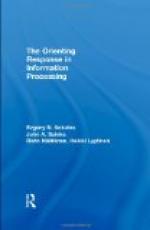|
This section contains 1,563 words (approx. 6 pages at 300 words per page) |

|
The orienting reflex (OR) is a complex response of the organism to a novel stimulus. It was discovered by Ivan Pavlov ([1927] 1960) as an interruption of ongoing activity by presentation of an unexpected stimulus (external inhibition). This inhibition of the ongoing activity, accompanied by somatic, vegetative, electroencephalographic, humoral, and sensory manifestations, was termed the "what-is-it reflex." The OR is a set of components contributing to optimize the conditions of stimulus perception. A sequence of ORs directed toward new aspects of the environment constitutes an exploratory behavior. The somatic components of the OR are represented by eye and head targeting movements, perking of ears, and sniffing. The vasoconstriction of peripheral vessels and vasodilation of vessels of the head, heart rate deceleration, and skin galvanic response (SGR) constitute vegetative OR components. Positron Emission Tomography has demonstrated enhancement of blood supply in different brain areas during sensory stimulation...
|
This section contains 1,563 words (approx. 6 pages at 300 words per page) |

|


